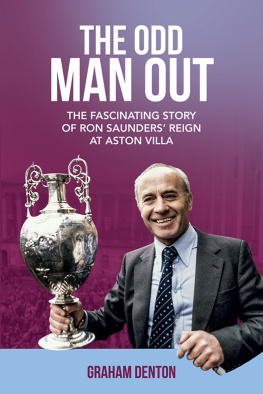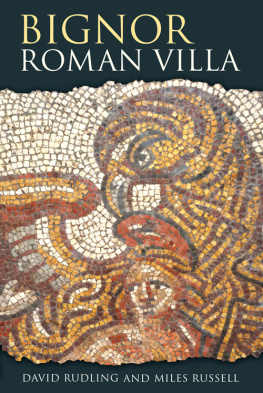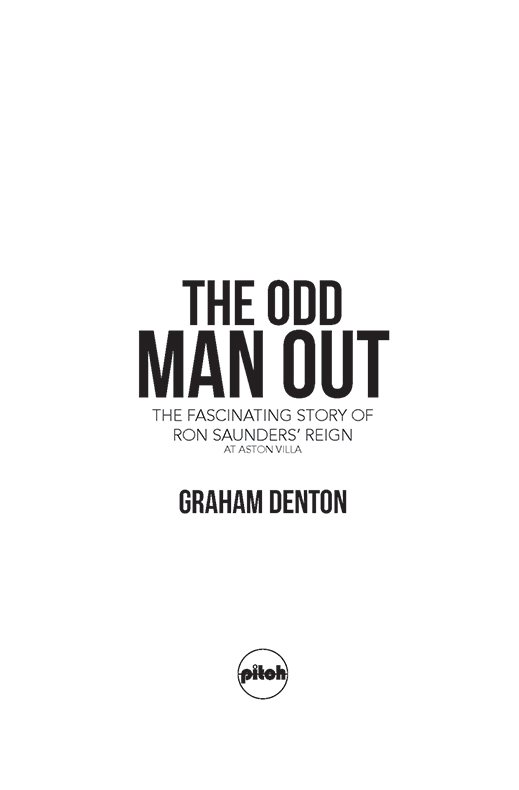First published by Pitch Publishing, 2017
Pitch Publishing
A2 Yeoman Gate
Yeoman Way
Durrington
BN13 3QZ
www.pitchpublishing.co.uk
Graham Denton, 2017
All rights reserved under International and Pan-American Copyright Conventions. By payment of the required fees, you have been granted the non-exclusive, non-transferable right to access and read the text of this e-book on-screen. No part of this text may be reproduced, transmitted, downloaded, decompiled, reverse-engineered, or stored in or introduced into any information storage and retrieval system, in any form or by any means, whether electronic or mechanical, now known or hereinafter invented, without the express written permission of the Publisher.
A CIP catalogue record is available for this book from the British Library
Print ISBN 978-1-78531-283-0
eBook ISBN 978-1-78531-333-2
--
Ebook Conversion by www.eBookPartnership.com
Contents
Villa have been a great club,
are still a great club, and
always will be a great club.
Fred Rinder, Aston Villa
chairman, 1936
Acknowledgements
F OR helping guide The Odd Man Out in the right direction, I would like to express my gratitude to Paul and Jane Camillin at Pitch Publishing, Derek Hammond and Gareth Davis, as well as to Duncan Olner of Olner Design Limited. Researching this book involved many long, painstaking but very enjoyable hours poring over numerous sources. A big thank you for the information they provided is due to every single person whose words I had the pleasure of reading. Aston Villa: The Complete Record by Rob Bishop and Frank Holt was a constant and particularly useful reference point throughout. Rob Bishop also warrants huge appreciation for reading my manuscript and making many beneficial suggestions. The views and opinions of so many ex-players, managers, coaches and journalists have been invaluable in my painting a more rounded picture and Im extremely grateful for that. Wherever possible, credit is given in the text to the books from which Ive quoted. Throughout the writing process, the encouragement of my wife Dianna and my most loyal supporter James Carter was a much welcome rock. Lastly, I am especially indebted to two former Villa players, John Deehan and Gordon Smith, for taking the time to reply to my communications. Shortly after our correspondence, Gordon Smith passed away and this book is dedicated to his memory, as well as to all the Villans whove gone before and all those still to come.
Introduction
Im the odd man out; the one who, as a youngster, had no burning ambitions about becoming a professional footballer and scoring the winning goal at Wembley by the time I was 24 or 25, I had become obsessed with the idea of managing a professional club and making my mark on that side of the game.
Ron Saunders Aston Villa Scrapbook
S OMEONE on a Facebook page celebrating football nostalgia had uploaded a photo of Ron Saunders. In it, holding aloft the League Cup trophy his Aston Villa side had just won, Saunders played host to a cheery grin that spread from ear to ear. The picture, one poster commented, had clearly been Photoshopped. Why? Because Saunders looked happy! Witty as it may have been, it was a typical observation about the manager. With what ATV commentator Hugh Johns once called his gloomy face and sometimes glowering expression, Saunders was persistently caricatured for his joylessness, the only Scouser in the world without a sense of humour. He did come over as a miserable old git, another online contributor added.
In Best, Pel and a Half-time Bovril by Andrew Smart, the author describes Saunders as a hard man, taciturn, rarely seen with a smile. It is another archetypal image. Mention the name and it almost instantly summons a flurry of similar epithets: Sergeant major Saunders, Mister 110 per cent, The Iron Man. Stock encapsulations are bandied about. He was a tough guy, a no-nonsense character, a strict disciplinarian. Very few are meant to be complimentary. Such was the impression of the Birkenhead-born boss as a sourpuss, when the fledgling football fanzine When Saturday Comes first set up in 1986, the editorial in its initial issue posited as one of the questions it sought to answer, Does anybody in football actually like Ron Saunders?
With his penchant on matchdays for sporting a long, leather coat (and often matching black gloves), Saunders appeared to be soccers answer to The Sweeneys Jack Regan or, possessing a passing resemblance to Bob Hoskins in The Long Good Friday, seemed more East End gangster than football boss. Cynics were certain he wore it simply to look even more sinister! The general belief was that he had a personality to match. Saunders, wrote Richard Whitehead in The Soul of Aston Villa in 50 Moments, with a touch of exaggeration for amusing effect, was just about the scariest man in the game, able to turn players, journalists and possibly even members of his own family into quivering wrecks with just one hard stare.
Whenever lists are compiled of the top British football bosses of all time, cast-iron certainties to be heading the queue are Sir Matt Busby, Bill Shankly, Bob Paisley, Don Revie, Brian Clough, Sir Alf Ramsey, Jock Stein, Bill Nicholson, Herbert Chapman and the most successful club manager of the modern era, Sir Alex Ferguson. Youll seldom, if ever, find Saunders keeping them company. In fact, in a 2009 poll of the 50 greatest managers in British football history run by the Daily Mail, he only registered with the various contributors at a lowly number 43. One place above him was Jim Smith. A manager who could make ordinary players do great things, Smart also writes of him. He remains, however, rarely anything more than a figure in the background.
Of course, there are enough related tales about him to give them some credence, but the abiding public perception of Saunders as a tyrant who mishandled his players, upset his coaching staff and fought with members of the boardroom has undoubtedly overshadowed his achievements. While, in terms of actual silverware, the trophies his teams won were relatively few, Saunders accomplishments were nonetheless significant and deserving of recognition. Certainly they were far more than many of his managerial peers.
BBC sports broadcaster Pat Murphy wrote in the Birmingham Post in 2006, If any journalist manages to unpick that lock, the memoirs of Ron Saunders would be fascinating. Fascinating, yes. But as with any memoir they would only show one side of the coin. Besides, Saunders famous reticence when it comes to talking about himself means those memoirs will never see the printers ink. The Odd Man Out the title taken from a description Saunders gave to himself isnt an out-and-out biography. Its primarily the story of Saunders time at Aston Villa and the relationship he and the football club shared during a period in which Saunders enjoyed if that is the correct word his greatest success. Its a story worth telling. Ron Saunders may not have been one of its main protagonists but without his presence the portrait of English football in the 1970s and 1980s would undoubtedly be much, much less.
Revolutions
A T three oclock that Saturday afternoon, had the ten bells tolled in the tower of the towns crooked spire barely half a mile away, not a soul at Saltergate would have heard a sound. The home of Chesterfield FC, one of the oldest grounds in the Football League, was playing host to one of its oldest members, Aston Villa. Most of them coming from the West Midlands, 16,689 more than double the Derbyshire clubs usual gate were there. Close to kick-off, spilling in their dozens on to the sloping pitch, the Villa fans had forced a call for calm from the teams manager Vic Crowe. Urging them to cease their surges, it took a megaphone to get his message over. Their fervour was understandable. The date was 15 August 1970. It was the opening day of the 1970/71 season. It was also the first time in their 96-year history that Aston Villa were competing in the third tier of English football.













